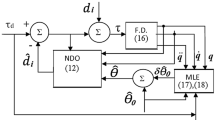Abstract
The notion of zero dynamics of a nonlinear system is used in the investigation of three classes of problems that arise in advanced robotics: control of robots in rigid contact with the environment, free motion control of manipulators with redundant degrees of freedom, and trajectory control of robot arms with flexible links. In each case, the internal dynamics present in the system when a proper output is constrained to be zero is characterized, and a physical interpretation of such dynamics is provided. Simple examples are worked out to show how this analysis supports the design of stabilizing controllers, and that existing results can be reviewed in the spirit of zero dynamics.
Access this chapter
Tax calculation will be finalised at checkout
Purchases are for personal use only
Preview
Unable to display preview. Download preview PDF.
Similar content being viewed by others
References
A. Isidori, Nonlinear Control Systems, 2nd Edition, Springer Verlag, Berlin, 1989.
H. Goldstein, Classical Mechanics, Addison-Wesley, Reading, 1980.
H. Asada and J.-J.E. Slotine, Robot Analysis and Control, John Wiley, New York, 1986.
T.J. Tarn, A.K. Bejczy, A. Isidori, and Y. Chen, “Nonlinear feedback in robot arm control,” Proc. 23rd IEEE Conf on Decision and Control (Las Vegas, NV, Dec. 12–14, 1984), pp. 736–751.
K. Kreutz, “On manipulator control by exact linearization,” IEEE Trans. on Automatic Control, vol. AC-34, no. 7, pp. 763–767, 1989.
C. Byrnes and A. Isidori, “Local stabilization of critically minimum phase nonlinear systems,” Systems and Control Lett., vol. 11, no. 1, pp. 9–17, 1988.
A. Isidori, C.H. Moog, and A. De Luca, “A sufficient condition for full linearization via dynamic state feedback,” Proc. 25th IEEE Conf. on Decision and Control (Athens, GR, Dec. 10–12, 1986), pp. 203–208.
C. Byrnes and A. Isidori, “Asymptotic properties of nonlinear minimum phase systems,” in New Trends in Nonlinear Control Theory, J. Descusse, M. Fliess, A. Isidori, and D. Leborgne Eds., Lecture Notes in Control and Information Sciences, vol. 122, pp. 254–264, Springer Verlag, 1989.
A. Isidori and C. Byrnes, “Output regulation of nonlinear systems,” IEEE Trans. on Automatic Control, vol. AC-35, no. 2, pp. 131–140, 1990.
A. Isidori and C.H. Moog, “On the nonlinear equivalent of the notion of transmission zeros,” in Modelling and Adaptive ControlC.I. Byrnes and A. Kurzhanski Eds., Lecture Notes in Control and Information Sciences, vol. 105, pp. 146–158, Springer Verlag, 1988.
S.N. Singh, “A modified algorithm for invertibility in nonlinear systems,” IEEE Trans. on Automatic Controlvol. AC-26, no. 2, pp. 595598, 1981.
N.H. McClamroch and D. Wang, “Feedback stabilization and tracking in constrained robots,” IEEE Trans. on Automatic Control, vol. AC-33, no. 5, pp. 419–426, 1988.
A. De Luca, C. Manes, and F. Nicolò, “A task space decoupling approach to hybrid control of manipulators,” Proc. 2nd IFAC Symp. on Robot Control (SYROCO’88) (Karlsruhe, FRG, Oct. 5–7, 1988), pp. 157–162.
D.N. Nenchev, “Redundancy resolution through local optimization: a review,” J. of Robotic Systems, vol. 6, no. 6, pp. 769–798, 1989.
T. Shamir and Y. Yomdin, “Repeatability of redundant manipulators: mathematical solution of the problem,” IEEE Trans. on Automatic Controlvol. AC-33, no. 11, pp. 1004–1009, 1988.
P. Hsu, J. Hauser, and S. Sastry, “Dynamic control of redundant manipulators,” J. of Robotic Systems, vol. 6, no. 2, pp. 133–148, 1989.
A. De Luca and G. Oriolo, “The reduced gradient method for solving redundancy in robot arms,” Prepr. 11th IFAC World Congress (Tallinn, Estonia, Aug. 13–17, 1990 ), vol. 9, pp. 143–148.
A. De Luca and G. Oriolo, “Efficient dynamic resolution of robot redundancy,” Proc. 1990 American Control Conf. (San Diego, CA, May 23–25, 1990 ), pp. 221–227.
M.C. Good, L.M. Sweet, and K.L. Strobel, “Dynamic models for control system design of integrated robot and drive systems,” ASME J. of Dynamic Systems, Measurement, and Control, vol. 107, no. 3, pp. 5359, 1985.
L. Meirovitch, Analytical Methods in Vibrations, Macmillan, New York, 1967.
M.W. Spong, “Modeling and control of elastic joint robots,” ASME J. of Dynamic Systems, Measurement, and Control, vol. 109, no. 3, pp. 310–319, 1987.
A. De Luca, “Dynamic control of robots with joint elasticity,” Proc. 1988 IEEE Int. Conf. on Robotics and Automation (Philadelphia, PA, Apr. 24–29, 1988 ), pp. 152–158.
S. Nicosia, P. Tornei, and A. Tornambè, “Dynamic modelling of flexible robot manipulators,” Proc. 1986 IEEE Int. Conf. on Robotics and Automation, (San Francisco, CA, Apr. 7–10, 1986 ), pp. 365–372.
R.H. Cannon, Jr. and E. Schmitz, “Initial experiments on the endpoint control of a flexible one-link robot,” Int. J. of Robotics Research, vol. 3, no. 3, pp. 62–75, 1984.
A. De Luca, P. Lucibello, and G. Ulivi, “Inversion techniques for trajectory control of flexible robot arms,” J. of Robotic Systems, vol. 6, no. 4, pp. 325–344, 1989.
A. De Luca, L. Lanari, and G. Ulivi, “Nonlinear regulation of end-effector motion for a flexible robot arm,” in New Trends in Systems Theory,G. Conte, A.M. Perdon, B. Wyman Eds., Birkhäuser, Boston, to appear.
E. Bayo, “A finite-element approach to control the end-point motion of a single-link flexible robot,” J. of Robotic Systems, vol. 4, no. 1, pp. 63–75, 1985.
Author information
Authors and Affiliations
Editor information
Editors and Affiliations
Rights and permissions
Copyright information
© 1991 Springer Science+Business Media New York
About this chapter
Cite this chapter
De Luca, A. (1991). Zero Dynamics in Robotic Systems. In: Byrnes, C.I., Kurzhansky, A.B. (eds) Nonlinear Synthesis. Progress in Systems and Control Theory, vol 9. Birkhäuser, Boston, MA. https://doi.org/10.1007/978-1-4757-2135-5_5
Download citation
DOI: https://doi.org/10.1007/978-1-4757-2135-5_5
Publisher Name: Birkhäuser, Boston, MA
Print ISBN: 978-0-8176-3484-1
Online ISBN: 978-1-4757-2135-5
eBook Packages: Springer Book Archive




